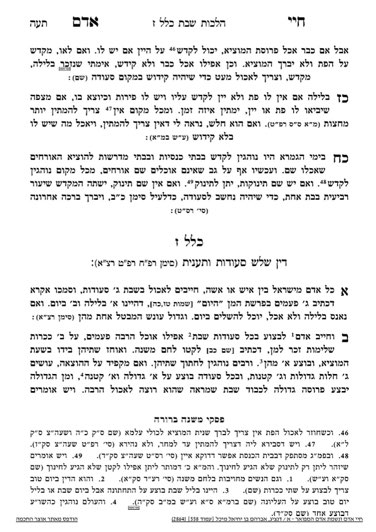The current series, which will cover seudos Shabbos and fasting on Shabbos, is available for sponsorship. Please contact Rabbi Reingold for more information.
We are continuing in siman 2, discussing the halachos of lechem mishneh. We learned about the concept of cutting through both challos at each seudah, to fulfill the Zohar’s requirement of 12 challos. If a person does not wish to be left with too much cut up challah, the Chayei Adam writes that a person can make three larger challos and three small ones.
In explaining the “size” smallest The Gra says that the minimal size of each challah should minimally be a k’beiah. However, there are others who hold that the size of a kezayis is sufficient. A roll which is less than the size of a kezayis is not preferred in halacha for lechem mishneh.
The Chayei Adam continues, and writes that there is an opinion that one does not need to use lechem mishneh for shalosh seudos. This opinion is brought down by the Shulchan Aruch in siman 291, where the Shulchan Aruch requires two, the Rema brings an opinion that one is enough but concludes that it is appropriate to be machmir. The Mishnah Berurah says that the opinion to use two is the primary halacha, and using only one applies when a person does not have a choice.
The Chayei Adam explains the source for this opinion. In the desert, Klal Yisroel would receive one omer of man per day. On Erev Shabbos, they would receive two omer. Normally, they would have two meals a day, one in the morning and one in the evening, so they would split their man into two loaves. If so, on Erev Shabbos, they would eat one loaf in the morning (Friday Morning), in the evening (Friday Night), and in the morning (Shabbos morning) so they would be left with just one loaf for shalosh seudos. This idea was originally brought in the Mordechai.
However, this calculation assumes that they simply split the man into two loaves and ate exactly one loaf at each meal. It is difficult to understand this thought process, as we don’t know whether they made them into one loaf per meal or any other form. The primary opinion is to fulfill lechem mishneh at shalosh seudos as well.
If a person does not have a full challah, they can still fulfill the mitzvah of seudas Shabbos, which is fulfilled regardless of whether the person has lechem mishneh. Separately, there is a concept of lechem mishneh, but each requirement (lechem mishneh and seudas Shabbos) is not meakeiv the other.
The Chayei Adam writes that when a person has shleimin, they should have in mind to help fulfill everyone’s Chiyuv, and those listening should have in mind to fulfill their chiyuv through person in a case where not everyone has their own lechem mishneh.
Summary
- Preferably, one should not make a challah less than 1 k’beisah. Minimally, it can be 1 kezayis.
- Seuda shlishis requires lechem mishneh.
- One can fulfill seudas shabbos even if they do not have lechem mishneh.
- If one person has lechem mishneh, if he says hamotzi and is motzi others, they also fulfill lechem mishneh. If they say their own bracha of hamotzi after he cut the challos, they are not yotzei lechem mishneh.



